This exercise runs a simple DOE study on a cantilever beam to examine the influence of the length, width, and height of the beam on its volume, maximum bending stress, and deflection. We would like to know all of the main effects and all of the interactions between the beam's dimensions, so full factorial is used for this DOE study. The base input Templex template, beam.tpl, defines three input variables (L, B, and H) for the beam dimensions labeled as length, width, and height, respectively (see figure below).
The sample base input template beam.tpl used in this tutorial can be in <hst.zip>/HS-2005/ and copied to your working directory.
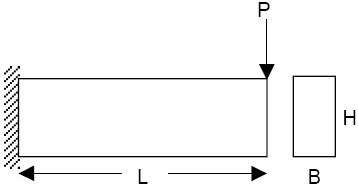
Cantilever Beam
{parameter(L,"Length",50,50,100)}
{parameter(B,"Width",2.5,2.5,5)}
{parameter(H,"Height",5,5,10)}
{P = 100}
{E = 2e11}
{M = P*L}
{c = H/2}
{I = (B*H^3)/12}
{MAX_STRESS = (M*c)/I}
{MAX_DISP = (P*L^3)/(3*E*I)}
{VOLUME = B*H*L}
{MAX_STRESS}
{MAX_DISP}
{VOLUME}
In this exercise, you will learn how to:
| • | Extract output responses for a DOE study |
| • | Perform post processing and evaluate the results |
| • | Observe the interactions between variables |
| • | Add approximations for a regression equation |
This setup requires you to add a study and load the input file into HyperStudy. The input variables for the DOE study (length, width, and height) are selected as factors. A nominal run is performed (with Templex as the solver), and the output responses for the DOE study are selected (in this case: volume, max. stress, and max. displacement).
| 2. | To start a new study, click File > New from the menu bar, or click  on the toolbar. on the toolbar. |
| 3. | In the HyperStudy – Add dialog, enter a study name, select a location for the study, and click OK. |
| 4. | Go to the Define models step. |
| 5. | Add a Parameterized File model. |
| a. | From the Directory, drag-and-drop the beam.tpl file into the work area. |

| b. | In the Solver input file column, enter beam.tpl. This is the name of the solver input file HyperStudy writes during any evaluation. |
| c. | In the Solver execution script column, select Templex (templex). |

| 6. | Click Import Variables. Three input variables are imported from the beam.tpl resource file. |
| 7. | Go to the Define Input Variables step. |
| 8. | Review the input variable's lower and upper bound ranges. |
| 9. | Go to the Specifications step. |
|
| 1. | In the work area, set the Mode to Nominal Run. |
| 3. | Go to the Evaluate step. |
| 4. | Click Evaluate Tasks. An approach/nom_1/ directory is created inside the study directory. |
| 5. | Go to the Define Output Responses step. |
|
In this step you will create three output responses: Max_Stress, Max_Disp, and Volume.
| 1. | Create the Max_Stress output response. |
| a. | From the Directory, drag-and-drop the beam.tpl file, located in approaches/nom_1/run_00001/m_1, into the work area. |
| b. | In the File Assistant dialog, set the Reading technology to Altair® HyperWorks® and click Next. |
| c. | Select Single item in a time series, then click Next. |
| d. | Define the following options, then click Next. |
| • | Set Component to Column 1. |
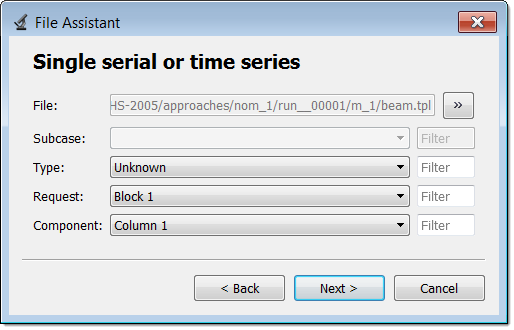
| e. | Label the output response Max_Stress. |
| f. | Set Expression to First Element. |
| Note: | Because there is only a single value in this vector, HyperStudy inserts [0] after v_1, thereby choosing the first (and only) entry in the vector. |
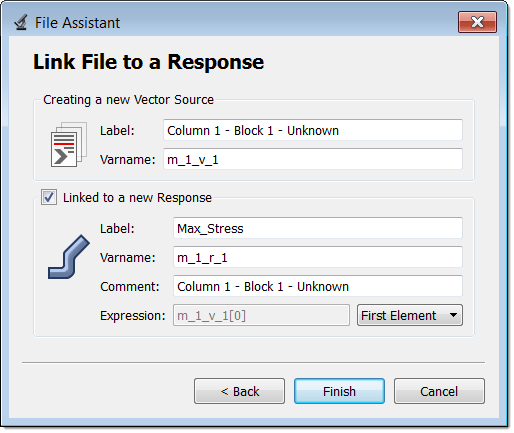
| g. | Click Finish. The Max_Stress output response is added to the work area. |
| 2. | Repeat step 1 to create the Max_Disp and Volume output responses. |
| 3. | In the Expression field: |
| a. | For Max_Disp, after v_2, change [0] to [1]. |
| b. | For Volume, after v_3, change [0] to [2]. |
| 4. | Click Evaluate Expressions to extract the output response values of each expression. |

|
The following steps illustrate how to set up a DOE approach through the selection of a DOE matrix and input variables. Input variables can either be controlled or uncontrolled. In this exercise, a full factorial DOE matrix is considered. This provides the main effect of the input variables and their interactions with one another for selected output responses. The length, width, and depth of the input variables are introduced as controlled and their effects are studied for the following output responses: maximum stress, maximum displacement, and volume.
| 1. | In the Explorer, right-click and select Add Approach from the context menu. |
| 2. | In the HyperStudy - Add dialog, select Doe and click OK. |
| 3. | Go to the Specifications step. |
| 4. | In the work area, set the Mode to Full Factorial. |
| 6. | Go to the Evaluate step. |
| 8. | Monitor the progress of the evaluation by clicking the Evaluation Data and Evaluation Plot tabs. |
| 9. | Go to the Post processing step. |
|
| 1. | Click the Linear Effects tab to review the main effect of each controlled parameter on a selected output response. |
Review the effects of a single input variable on an output response, or multiple input variables on an output response.
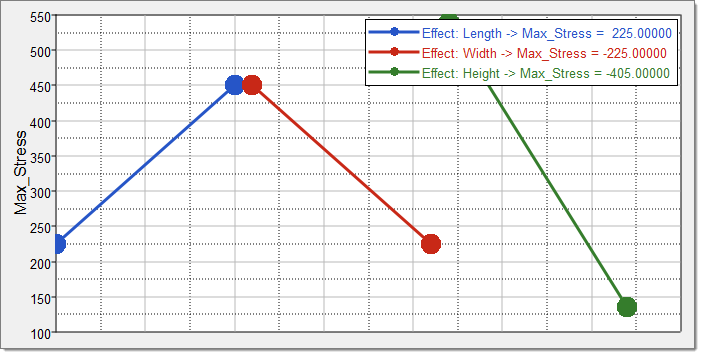
As illustrated in the plot above, as the length increases from 50 to 100 units, the max stress increases from 225 to 450. Increasing the width from 2.5 to 5 units decreases the max stress by the same amount. The contributions for max stress from both length and width are identical. Increasing the height from 5 to 10 units decreases the max stress by a larger extent (from 530 to 130). It is clear that for the max stress output response, height has a larger main effect than length or width.
Input Variable
|
Max Stress - lower bound
|
Max Stress - upper bound
|
Length
|
225
|
450
|
Width
|
450
|
225
|
Height
|
540
|
135
|
| 2. | Click the Distribution tab to review a histogram of Max Stress. |
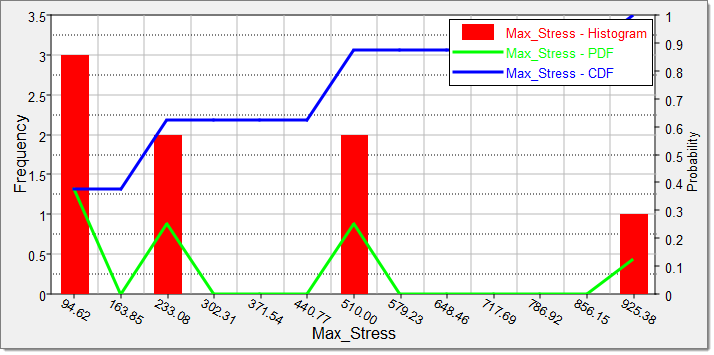
|
In the following steps, you will create approximations for the DOE study. A first order regression equation for each output response (Max Stress, Max disp, and Volume) is created based on the DOE study. Since the input variables are of two levels, only the first order equation can be generated.
| 1. | In the Explorer, right-click and select Add Approach from the context menu. |
| 2. | In the HyperStudy - Add dialog, select Fit and click OK. |
| 3. | Go to the Select matrices step. |
| 5. | In the HyperStudy - Add dialog, add one matrix. |
| 6. | In the Matrix Source column, select Doe 1 (doe_1). |
| 7. | Click Import Matrix. The matrix from the DOE is imported into the Fit approach. |
| 8. | Go to the Specifications step. |
| 9. | In the work area, set the Mode to Least Squares Regression (LSR). |
| 11. | Go to the Evaluate step. |
| 13. | Go to the Post processing step. |
| 14. | Click the Residuals tab. |
The Residuals table displays the difference between the output response value from the solver and the output response value calculated from the regression equation. This table can also be used to determine which runs are generating more errors in the regression model. The % error column shows that the predicted output response is not close to the observed value. The % error can be reduced if more levels are chosen for example, using a three-level design in this exercise.

| 15. | Click the Trade-Off 3D tab to plot output responses vs. input variables. |
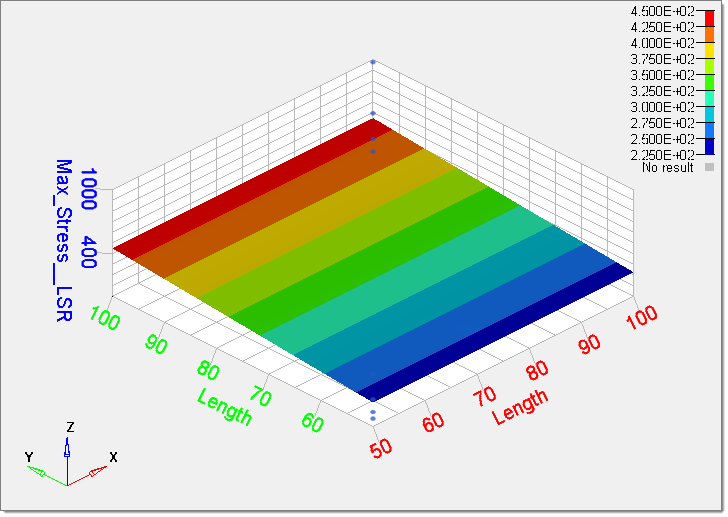
|
See Also:
HyperStudy Tutorials


















